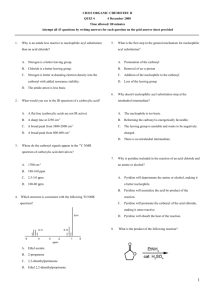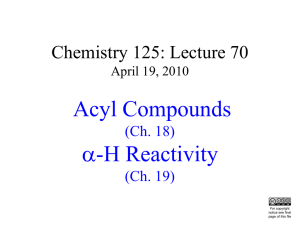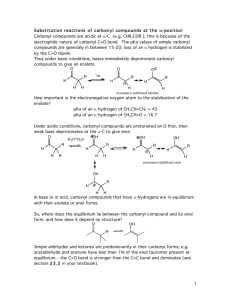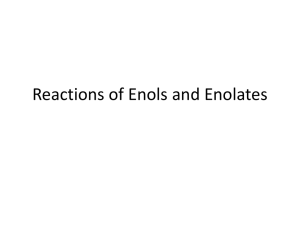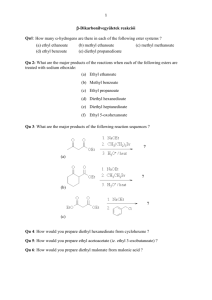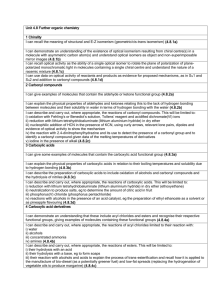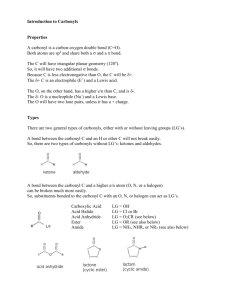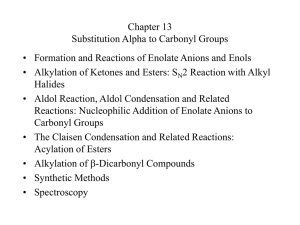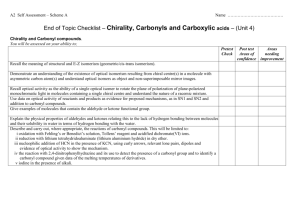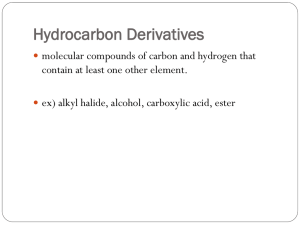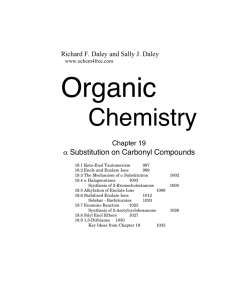Ch 22 Carbonyl Alpha (a) Substitution
advertisement
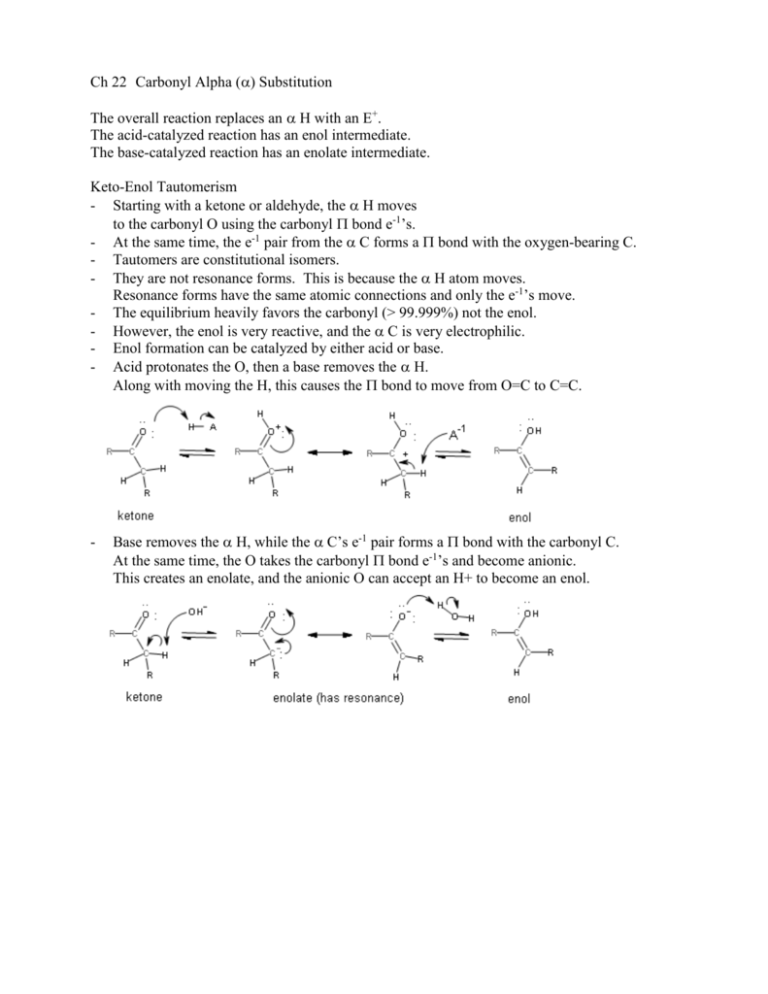
Ch 22 Carbonyl Alpha () Substitution The overall reaction replaces an H with an E+. The acid-catalyzed reaction has an enol intermediate. The base-catalyzed reaction has an enolate intermediate. Keto-Enol Tautomerism - Starting with a ketone or aldehyde, the H moves to the carbonyl O using the carbonyl bond e-1’s. - At the same time, the e-1 pair from the C forms a bond with the oxygen-bearing C. - Tautomers are constitutional isomers. - They are not resonance forms. This is because the H atom moves. Resonance forms have the same atomic connections and only the e-1’s move. - The equilibrium heavily favors the carbonyl (> 99.999%) not the enol. - However, the enol is very reactive, and the C is very electrophilic. - Enol formation can be catalyzed by either acid or base. - Acid protonates the O, then a base removes the H. Along with moving the H, this causes the bond to move from O=C to C=C. - Base removes the H, while the C’s e-1 pair forms a bond with the carbonyl C. At the same time, the O takes the carbonyl bond e-1’s and become anionic. This creates an enolate, and the anionic O can accept an H+ to become an enol. Reactivity of Enols - The enol is a Nu and has resonance, where the O donates an e-1 pair to its C. At the same time, the C=C bond e-1’s move to the C as a lone pair. - This leaves the C as an anion (Nu) which can attach to an E+. - In the final step, base removes H+ from the O. The carbonyl bond remains. Halogenation of Aldehydes and Ketones - Follows acid-catalyzed (enol) mechanism. - Uses Br2, Cl2, or I2 in acid solution (typically acetic acid or aqueous HX). - Rate-determining step is the initial protonation of the carbonyl O to form the enol. Reaction rate depends on concentration of the acid, not the halogen. - The C of the enol then reacts quickly with the halogen using the bond e-1’s. - Base removes the proton from the carbonyl O in the last step. - The halogenated product can undergo dehydrohalogenation to form a conjugated enone. This occurs by E2 when heated in pyridine. Bromination of Carboxylic Acids (HVZ Reaction) - Carboxylic acids, along with esters and amides, do not enolize significantly. - Acid bromides can enolize, however, and the acid bromide enol can form an -bromo acid bromide. - Addition of Br2 and PBr3 to a carboxylic acid sequentially forms an acid bromide plus HOPBr2 (or H3PO3), then the acid bromide enol, and then the -bromo acid bromide. - Then, addition of water hydrolyzes the -bromo acid bromide to form an -bromo carboxylic acid. PBr3 . . (H2O) Br2 HOPBr2 . . . (or H3PO3) Carboxylic Acid Acid Bromide Acid Bromide Enol Brominated Acid Bromide Brominated Acid . Acidity of H atoms - When the H has been removed from an enol, the conjugate base anion is an enolate. - The enolate is stabilized because it has nonequivalent resonance forms. - In both resonance forms, the C is sp2 with either a lone pair or a bond. - Unlike the keto-enol tautomers, only e-1’s are transferred between the resonance forms. - The H is only very weakly acidic, and is only removed by a very strong base, such as NaH or LiN(iPr)2 (lithium diisopropylamide or LDA). - LDA (at right) is particularly useful because the isopropyl groups allow it to be soluble in organic solvents, such as THF. - The best H’s (most easily removed) are those directly between two carbonyl groups, such as in 1,3-diketones. The enolates of these dicarbonyl compounds have three resonances forms because both carbonyl O’s can share the negative charge. Having more resonance forms results in higher stability for the enolate. : .. -1 : : : : : : : : : .. : : -1 .. -1 - - The relative acidity of dicarbonyl compounds is indicated by their pKa’s (9 - 13). Their pKa’s are much higher than those of carboxylic acids (~5), but also lower than those of water and alcohols (~16) and of monocarbonyl compounds, such as aldehydes, ketones, and esters (16, 19, and 25, respectively). The H atoms of nitriles are also acidic (pKa ~ 25). Again, the acidity is a result of resonance in the enolate anion. Enolate Ion reactivity - Stable solutions of pure enolate ions can be prepared with stoichiometric amounts of very strong base. This is in contrast to enols, which are not favored at equilibrium by more than 0.001%. - Enolate ions are also more reactive than enols. They are better Nu’s as a result of their negative charge. - Both the O and the C atoms can bond to an E+. However, our focus will be primarily on reactions with the C. Halogenation of Enolates (Haloform Reaction) - Addition of halogens to methyl C atoms of methyl ketones can be accomplished with NaOH and X2. (NaH and LDA are not required.) - Complete conversion to enolate is not required either because of the enolate’s reactivity. The enolate anion reacts quickly once formed. - The halogenated molecule is even more reactive because the e-1 withdrawing induction of the halogen further stabilizes the enolate. This causes the methyl C to add two more halogens. - The CX3 group attached to the carbonyl then functions as a leaving group in a basic hydrolysis (Nu acyl substitution) to carboxylic acid. Deprotonation of the carboxylic acid by CX3-1 creates CHX3 (chloroform, bromoform, or iodoform). - Alkylation of Enolate Anions - An enolate anion can function as a Nu in an SN2 reaction with an alkyl halide. - For the alkyl halide to function as an SN2 substrate, it must be methyl or primary. 1o allylic and 1o benzylic work very well. - The halide can be Cl, Br, I, or tosylate. - If the carbonyl compound has two H atoms, then two alkyl groups can be added. Base : resonance . SN2 Malonic Ester Synthesis - Malonic acid is the common name for propanedioic acid. Diethyl propanedioate (or malonate) is used as the dicarbonyl compound. - An alkoxide, such as NaOEt (sodium ethoxide), is used in alcohol solvent to deprotonate the ester’s carbon. - One or two alkyl groups can be added to the ester. - Once the alkyl groups are added, and the diesters are hydrolyzed into dicarboxylic acids, acid and heat can be used to remove one of the carboxylate groups. The process is called hydrolysis and decarboxylation. -CO2 substituted malonic acid - diacid loses CO2 acid enol carboxylic acid Decarboxylation is unique to carboxylic acids that have a second carbonyl on a beta carbon. This is because it occurs only by a cyclic mechanism that involves an acid enol. After decarboxylation, the result is RCH2COOH or R2CHCOOH, where R is from the alkyl halide(s). Also, the two R’s are not necessarily identical. (Two different alkyl halides can be used.) . Acetoacetic Ester Synthesis - Acetoacetic acid is the common name for 3-oxobutanoic acid, which essentially consists of an acetyl group attached to the C of acetic acid. Ethyl 3-oxobutanoate (or acetoacetate ester) is used as the dicarbonyl reactant. - The reaction sequence is otherwise identical to that of the malonic ester synthesis, and can include the hydrolysis and decarboxylation process as well. - After decarboxylation, the result is (RCH2)CH2COCH3 or (RCH2)2CHCOCH3. Again, two different alkyl halides can be used. Direct Alkylation of Ketones, Esters, and Nitriles - Monocarbonyl compounds, as well as nitriles, can also be alkylated. However, alkoxide is not basic enough to remove the H atom. - LDA in THF must be used instead to create the enolate.
